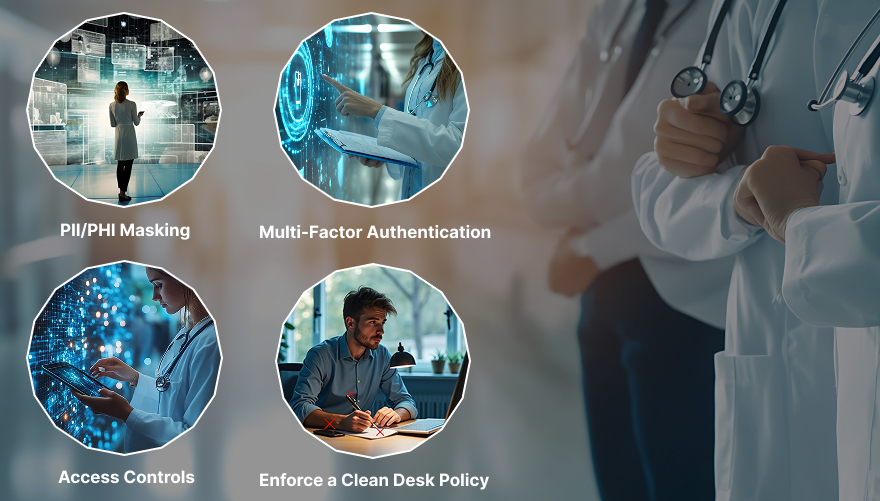As the healthcare industry works inter-connected and relies upon digital platforms more than ever, data breach incidents are also rising significantly.
In fact, a study done by IBM revealed that the healthcare industry is leading the position in recording the highest data breaching and cyber attack events around the world.
Moreover, an average data breach incident in healthcare organizations costs around $10.1 million, standing out as the highest among all industries.
That’s why almost all organizations in the healthcare industry appoint a CISO to safeguard their confidential data and ensure compliant-friendly behavior in all employees.
But how would you, as a CISO, ensure your organization protects personal health information (PHI) and complies with enterprise-grade security regulations in this digital landscape?
In this blog, we will explore key threats to healthcare data, emerging trends, and best practices CISOs can adopt to overcome these challenges, with a focus on how to prevent data breaches in healthcare.
What is a data breach?
Data breach can happen when an unauthorized person can view, steal, or share your sensitive data. Usually, data breaching can happen intentionally or by accident, as a consequence of gaps in technological setups or non-compliant user behaviors.
What is a data breach in healthcare?
The healthcare data breach is a subset of cyber security data breach.
The healthcare industry is one of the sectors that handles a massive amount of sensitive information on a regular basis. This information can include personal identifiers, numbers, date of birth, social security data breaches (social security numbers), financial credentials, insurance details, patient information, etc.
When such confidential data is exposed to unauthorized users, either by accident or intentionally, then it leads to data breaches in the healthcare industry. As a result, data breaching can damage your reputation, diminish customer’s trust, and cause heavy fines or legal penalties.
Key Risks and Threats to Healthcare Data

Here are some of the major threats and risks involved in the healthcare industry that a CISO should know:
Insider threats
Recently, Verizon surveyed over 30,000 security incidents across 94 countries and observed that insider threats such as privilege misuse, miscellaneous errors, and system intrusions account for the maximum risks for healthcare data in 2023.
Insider threats can occur due to various reasons– When your employees make innocent mistakes in operations, look for ways to damage the organization’s reputation due to personal issues, or sell confidential data for money.
Regulatory non-compliance
When your organization fails to comply with enterprise-grade security regulations such as HIPAA or GDPR, it can lead to unwanted legal penalties and heavy fines. Usually, non-compliance issues happen when there is technological gaps, insufficient employee training, ineffective data security strategies, or unplanned incidents.

Protect Your Healthcare Data from Insider Threats, Non-Compliance, and Third-Party Risks
Third-party risks
To delegate some processes such as invoicing, data management, or outsourcing solutions, many healthcare organizations partner with third-party vendors. As a CISO, you play a major role in facilitating and managing these partnerships.
If you don’t spend much time in assessing the security measures and data loss prevention (DLP) strategies of your vendors, then your data might be at risk and can cause significant damage to your company. In addition, a report by HIPAA observed, that over 35% of data breach incidents in the healthcare industry occurred because of third-party vendors.
Legacy systems
Over 73% of healthcare organizations still use outdated or legacy technologies to deal with data threats. With the continuous evolution of data threats, companies that are not adopting emerging technologies become vulnerable to risks.
Proactive Measures for CISOs to Adopt in 2025
A CISO is responsible for data protection by adopting preventive measures, creating response plans to threats, and adopting best practices that help organizations to comply with HIPAA and other security regulations.
Here is what you can do to tackle ever-evolving threats:
Continuous Education
Prioritize educating your staff about emerging threats and the consequences of breaching data protection laws is essential. Conduct regular sessions with your employees to show them step-by-step preventive measures on how to prevent data breach in healthcare.
Additionally, a recent report by IBM observed that companies can save data breach costs up to $258,629 by providing regular training and education sessions to their employees.
Investment in Technology
As data threats have risen over the years, it is essential to add an extra layer of protection to your security measures with the help of technology. Leveraging advanced technologies such as machine learning (ML) and artificial intelligence (AI) can help businesses in data encryption, data recovery, access control, threat detection, and response mechanisms.
It is projected that, in the next five years, healthcare organizations will invest around $125 million in advanced technologies to overcome the challenges of cybersecurity, emphasizing the need for innovation growth.
Regular Risk Assessments
Besides wearing multiple hats to ensure data security, one of the core responsibilities of a CISO is to conduct regular risk assessments. Studies show companies that do regular risk assessments can reduce the chances of data risks by 30%. Conducting regular risk assessment tests can help you spot weaknesses and gaps in your security protocols, helping you implement corrective measures on time.
According to HIPAA guidelines, performing these risk assessments is a must at least once a year. In addition to this, if you have recently faced a data breach incident, implemented a new tech, or changed your operations, you should immediately do an assessment test.
Monitoring and Detection
Manual monitoring and detection systems can be ineffective and time-consuming, especially in this digital landscape, where cybercrimes are rising. Adopting robust systems that monitor data and compliance security in real-time and detect breaches instantly can help you to take proactive measures. Investing in technologies that offer real-time threat detection and response mechanisms can significantly transform your data security efforts.
How to Prevent Data Breach in Healthcare: Best Practices for CISO in 2025

Here are some data-breaching best practices that CISOs can adopt:
PII/PHI Masking
Implement technologies, such as AI, that help you to automatically mask Personally Identifiable Information (PII) or Protected Health Information (PHI) while hiding the rest of the information. Data masking in the healthcare industry is crucial as it minimizes data exposure even to your employees and third-party vendors.
In the healthcare industry, especially in customer support or testing phases, it is best to mask information that is not needed in the process, helping you to avoid unnecessary data exposure. Also, if you want your organization to comply with HIPAA, it’s mandatory to protect PHI as one of the HIPAA guidelines.
Access Controls
Strictly define strategies that strengthen access control, allowing only authorized users to see, share, and operate sensitive data. In addition, implementing role-based access control (RBAC) can help you to prevent unverified users from accessing the sensitive information by allowing only dedicated team members to handle data.
Multi-Factor Authentication
Multi-factor authentication (MFA) should be a must-have component in your information security strategy. In the healthcare sector, 61% of breaches occur due to stolen, weak, or compromised passwords. This means only setting up a password is not enough to prevent unauthorized access. That’s why adding up an extra layer of security that requires two or more steps to access the device or sensitive information is essential.
For instance, you can include facial authentication as a MFA step. Making this authentication process a part of the onboarding procedure will ensure your new employees are setting up face IDs other than login credentials. Unlike passwords, facial IDs are very rare to steal or copy. This practice will enable users to scan their faces before accessing to confidential information, restricting access to cybercriminals.
Incident Response Plan
Create comprehensive strategies on steps you will take during the times of threat detection. Investing in advanced technologies, with built-in response mechanisms, can help you to automate initial defense responses.
These technologies can immediately lock or blackout system screens when a threat is detected to prevent further data exposure. In addition, it alerts managers to ensure necessary steps are taken on time. A well-defined incident response plan can help you to minimize potential damages and fix security gaps quickly.
Enforce a Clean Desk Policy (CDP)
Surprisingly, 53% of businesses left over 1,000 critical files and documents that other staff can access easily. With this in mind, a CISO should enforce a CDP that ensures all employees will maintain clean desk behavior. This means, that at the end of the day, no sensitive information should be left on the device or at the desk. Even during working hours, employees should keep their desks clean, ensuring there should be nothing at their desks to prevent unwanted data captures or thefts. In addition, employees should not leave their devices unattended and also dispose of any sensitive information from the system when the work is over.
Emerging Challenges for CISOs to Overcome Data Breach
In addition to industry-level data breach challenges, here are some emerging obstacles that CISOs face on a company level:
The Complexity of Digital Transformation & Remote Environments
As the healthcare industry is undergoing a digital transformation, the need to adopt robust security measures is equally important as the need to adopt new technologies. Moreover, when you are a CISO of a health insurance or outsourcing company–specifically in a remote work setup– you have to ensure that your teams are working with compliant behavior even in your physical absence.
Therefore, data security becomes more challenging when you have no idea how your employees are handling sensitive information during remote work.
Budget Constraints
CISOs receive pressure from stakeholders not only to implement information security strategies but also to find cost-effective ways to do so. Moreover, a recent report says that most of healthcare organizations spend only 6% of their budgets on cyber security.
How wAnywhere Can Help
wAnywhere offers AI-powered solutions to safeguard your sensitive data and help your business to stay compliant with enterprise-grade security regulations such as HIPAA, GDPR, and more. Our platform is purpose-built to empower the healthcare industry with advanced features like real-time threat detection and response mechanisms, access control, multi-factor authentications, and more.
With our AI-enabled platform, we help CISOs in:
- Deploying scalable and flexible security solutions within minutes without disrupting daily workflows.
- Building tailor solutions by offering APIs for every feature to cater to the unique needs of their business.
- Automating compliance security and data protection
- Ensuring instant data breach detection, and automating incident response and notifications.
- Ensuring implemented strategies are followed company-wide to meet global security standards.
- Implementing strengthened security measures in remote, hybrid, and in-office teams seamlessly.
- Integrating with a cost-effective and all-in-one platform to boost ROI.

Match enterprise-grade security standards with AI
Comply with HIPAA, detect real-time data breaches, and automate incident response with wAnywhere
Conclusion
The healthcare industry stands as a prime target for data breaches and cyber-attack activities. Although, handling sensitive data with care is the responsibility of all–from top to bottom–a CISO role is pivotal in ensuring that all the necessary steps for security protocols are implemented. It’s important to remember that as threats and technologies evolve with time, our strategies should also take shape accordingly. This blog covers all the latest strategies, from resource planning to tech implementation, that can help CISOs become aware of current data breach trends and what steps they can take to prevent data breaches in healthcare.
wAnywhere Blog
Check out the wAnywhere blog to learn more about our product, customer stories, and our take on meetings, remote working, productivity, and more.

